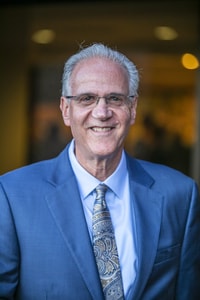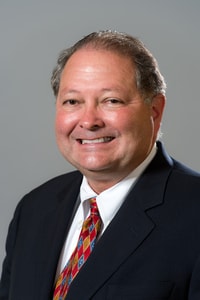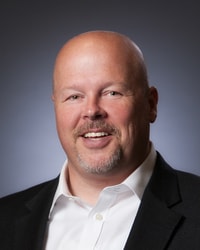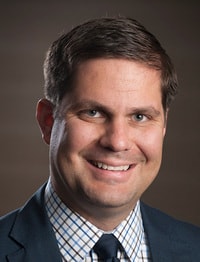 Choosing Wisely
Choosing Wisely
Anticipate a hybrid world where technology remains a tool rather than a takeover
What delineates, demarcates mission-driven vs. profit-driven supply chain?
Leaders & Luminaries sheds some light on how healthcare's expansive supply chain realm mirrors, shadows and diverges from other industries.
By Rick Dana Barlow
As the orchestral sounds moaned in the background, world-famous archeologist Henry "Indiana" Jones Jr., Ph.D., faced a monumental, if not life-threatening, decision.
Jones no doubt could hear his own heartbeat as the sweat dribbled down his forehead and the tension intensified inside the cave that housed the Holy Grail among an array of chalices guarded for centuries by the well-past-his-golden-prime Knight Templar. Nearby, Jones' father lay prostrate on the ground, succumbing in dramatic fashion to a bullet wound.
Meanwhile, Jones' rival, searching for the chalice believed to grant immortality, just ended up a pile of dust after allowing his female companion to pick the most ornate model and accepting her choice because he felt it befit the "King of kings." After drinking from the bejeweled cup and selfishly expecting his immortal reward, he began to retch, his body rapidly aging and disintegrating amid the shrill screams of his female companion. The Knight Templar punctuated the scene with, "He chose ... poor."
Through clever deductive reasoning with a hint of panicked desperation, Jones quickly concluded that because Jesus was the earthly son of a carpenter only the plainest and most unsophisticated cup would suffice. After locating his own choice, he filled the dull cup with "holy water" from the nearby cistern, drank some himself before giving his father to drink and pouring some on his father's gaping bullet wound. As the wound miraculously healed, Henry Jones Sr. winced in pain, then smiled with widened eyes as he realized the historical and religious significance of the weathered golden chalice he now held.
As if the Joneses didn't realize, the Knight Templar sliced through the tension with his verbal sword: "You have chosen ... wisely." (See https://www.youtube.com/watch?v=SGl9dBOJp9E.)
For college students majoring in or studying supply chain or anyone working in supply chain, their choice of a future or current career likely isn't as melodramatic as that climactic scene from the 1989 film, "Indiana Jones and the Last Crusade."
Important sidebar and unaddressed cinematic fact: We know that neither of the Joneses were granted immortality after drinking from the holy grail because by the next film in the series we learn that Indy's father had died and see that Indy himself had aged at least a decade.
In fact, for much of the 20th century in the healthcare industry, many supply chain executives, leaders, managers and professionals didn't necessarily begin their careers in anything called supply chain or resource management or materials management or a plethora of other departmental and functional title variations, for that matter. Originally, the department/function classification was purchasing, and if you didn't qualify with a background in accounting, business or logistics in some way, you likely "fell" into the basement-confined role because you knew someone or were related to someone and purchasing seemed to be the most innocuous place to put you if you needed a job.
Now juxtapose the historical stereotype of purchasing-as-afterthought to how the world learned about the essential nature and importance of supply chain during the nearly three-year global COVID-19 pandemic from 2020 to early 2023 — as if prior acts of terrorism, wars and weather phenomena and other crises and disasters didn't offer any earlier relevant clues.
These days, supply chain represents more than just simply buying stuff when ordered to do so by others of even marginal influence.
Regardless of industry, supply chain encompasses a variety of duties, functions, strategies, tactics and transactions, reinforcing those who steadfastly believe that the profession, by and large, is the same or similar throughout. Yet those who work in healthcare supply chain — particularly within provider organizations — embrace the notion that healthcare is "different," amplified by the complex nature of decision-making and transactional procedures, as recognized by those who leave manufacturing and retail for healthcare and vice versa.
To a degree, the function may be similar (yet not the same), but the customer, by and large, is different, if not loosely defined.
Meaning: Manufacturing and retail supply chain experience some of the same issues as healthcare, but consumer behaviors and purchasing processes are not so monolithic and arguably linear in healthcare as they are in other industries. Some contend that supply chain itself is not a linear concept, nor is it actually like a chain, which is circular. It's more like a network or even more accurately a web — of decisions, processes, relationships and transactions.
So how might healthcare supply chain be similar across the board but also "different" as promoted by those who distinguish "mission-based" from "profit-motivated" operations, regardless of an organization's tax status?
Bellwether League Foundation initially promoted the theme of its 2023 Healthcare Supply Chain Leadership Forum as "Healthcare's Place in the Panorama and Panoply of Supply Chain." The reasoning? Panorama evokes the deep and wide berth of responsibilities and accountability; panoply signifies the complete collection of functions, areas and tasks increasingly involved. During the Forum, which took place on Monday, October 2, at Marquette University in Milwaukee, the discussion centered on "Healthcare Supply Chain's Expanding Realm of Influence" within the industry — spanning provider, supplier and payer activities. To view the Forum video, click here: https://www.bellwetherleague.org/sliders/videos.php.
Some might equate the concept of supply chain to Henry Ford's legendary application of the assembly line with upstream ties to raw materials through manufacturing and assembly through distribution and retail sales (think, consumption) to waste disposal or recycling for contemporary concerns about sustainability.

Carl Meyer, Bellwether Class of 2019, Executive Vice President, The Wetrich Group, perhaps classified it most adroitly: "Healthcare is not like assembling a car," Meyer said. "You go into work every day not knowing what to expect in terms of who needs help and why." Meyer moderated the Forum's panel discussion.
Stacking up together
How might supply chain in healthcare mirror and shadow that in manufacturing and retail?
From the point of issuing purchase orders, requests for information (RFIs), requests for proposal (RFPs); ordering products via fax (yes, they still remain), electronic data interchange (EDI) or online exchange; managing receiving dock operations; stocking shelves in storerooms, supply closets or warehouses; and transporting products throughout organizational facilities, what happens within healthcare provider organizations, by and large, reflects what happens in manufacturing companies and retail outlets.
Much of what leads up to those functions and orbits around them remains a bit more specialized than universal.
Undaunted by industry designation, some experts blur explicit delineation between supply chain operations.

"Regardless of the type of products or services required, the principles and discipline of managing a supply chain are the same," said Tom Lubotsky, Bellwether Class of 2022, Vice President, Supply Chain, Allina Health, which is a Bronze Sustaining Sponsor. "Procure to pay, inventory management, sourcing and data management are all elements which are required to manage it appropriately. Overall, our healthcare supply chain industry is no different in ensuring that the product or service comes in at just the right time in the right place for use including the coordination of its storage, so nothing goes missing and is available for the user."

Rand Ballard, Chief Customer Officer, Vizient, which is a Founding Sustaining Sponsor, was even more direct, telling Leaders & Luminaries: "You have buyers and sellers, and you are sourcing products, some of which you know there will not be significant variation and you should be able to hone down to an efficient replenishment strategy," he indicated.

"The conversion of raw materials to finished product to delivery to end user is used in all industries," agreed Maria Hames, Partner, HealthCare Links, which is an Event Sponsor. "Many policy/procedures are similar — purchasing, distribution, inventory, suppliers, etc."

"Most of the processes in supply chain are similar regardless of what is being sourced: Vendor relations, negotiations, forecasting and contracting, etc.," noted Mary Starr, Bellwether Class of 2018, COO, Greenhealth Exchange (GX).
Still, others qualified the similarities to a degree.
Deborah Templeton, Bellwether Class of 2023, Chief Administrative Officer (retired), System Support Services, Geisinger, which is a Bronze Sustaining Sponsor, highlighted several areas.

"In 2012, SMI did a comparative survey of retail and provider supply chain practices," Templeton recalled. "At that time the only true similarities identified were the need to comply with regulatory requirements and the use of metrics. Rolling the tape forward, I think that these two similarities still stand. The use of metrics is probably closer linked to each other than before, although in healthcare the payer chain still makes many metrics hard to define and track. Since then, I also think that the use of data standards, having more visibility into the supply chain flows and the use of technology has been enhanced, especially in the provider community. There is more evidence of supplier collaboration and the use of score-carding than in the past.
"I also think that process engineering and efficiency methods are being applied in both sectors, with the adoption of these practices somewhat new in healthcare," she added. Templeton also is a past Chairman of Bellwether League Foundation's Board of Directors (2021-2022).

"The similarities between the healthcare supply chain other industries stem from the fact that they all aim to efficiently and effectively manage the flow of goods and services — procurement, inventory management, logistics and distribution and demand planning," echoed Jane Pleasants, Bellwether Class of 2015, Executive Director, SMI. "It takes collaboration and communication with key stakeholders to drive change."
David Hargraves, Senior Vice President (retired), Supply Chain Services, Premier, which is a Founding Sustaining Sponsor, contends that fundamentally, organizations across industries — and their customers/end users — are looking for reliable sources of supply that produce high-quality products, on time and in an efficient, cost-effective manner.

"Most industries rely on complex global supply chains with final product and raw materials manufactured and sourced from dozens of locations across the globe," Hargraves said. "In a post-pandemic world, ongoing global disruptions can continue to have far-reaching consequences across industries — affecting product production, distribution, availability and pricing.
"Organizations and teams today are becoming increasingly adaptive to change and proactive in measures that help ensure supply continuity," he continued. "As one example, the supply chain is on the cutting edge of technological advancements to meet the changing demands of the industry, with nearly 80 percent of global leaders saying they've accelerated digital transformation efforts to make their operations more responsive and forward-looking.
"Industries across sectors have an intense need to drive greater efficiencies, supply chain resiliency, and reduce inventories and costs. This is a particularly acute need in healthcare given the financial environment and challenged provider operating margins," Hargraves added.
Amanda Chawla, FACHE, CMRP, Chief Supply Chain Officer and Vice President, Stanford Medicine, which is a Bronze Sustaining Sponsor, busts the outdated historical definition of supply chain.

"The first way the healthcare supply chain is like other industries is the functions and dependencies on the entire supply network," Chawla said. "Supply chain is not a linear chain of events. Supply Chain is a network of coordination across activities, functions, logistics, and stakeholders across the continuum to deliver the right item at the right time, place, price, etc. — all the 'rights.' All industries procure, manage logistics and distribution, and manage demand forecasting. The degree to which procurement occurs to raw materials can differ from industry to industry. Still, we are all dependent upon a robust supply network that allows us to obtain supplies from raw materials to finished goods, and the logistics of the movement of goods are universal.
"Demand forecasting, at its core, is about matching supply to demand," Chawla continued. "It involves reviewing historical data, evaluating and considering current trends, and predicting future demand to match the supply. Demand forecasting is critical in any industry, whether you are making cars, in retail, or producing medical supplies for patient care."
Supply chains are more similar than they are different, according to Siobhan O'Bara, Senior Vice President, Community Engagement, GS1 US Healthcare, which is a Silver Sustaining Sponsor. She explains the process this way.

"Any supply chain — regardless of the product or service — is a balance of demand and supply," she indicated. "Someone needs to create demand — they want an item. Finding that item — with a clear understanding of what the item attributes and details are — creates the first step in a supply chain cycle. Moving from 'find' into 'buy' triggers a purchase with a demand signal. This involves pricing, inventory management, customer and order details and payment, and launches the order process. For healthcare items, more likely than not, we now progress to the traceability step of sequence. What are the required traceability steps for this item — chain of custody, authentication of provenance, correctly recorded details of where the item has been as well as where it is going? A multitude of details are critical to patient safety and oversight. Lastly, the order needs to be fulfilled — moved out of inventory, packed for shipment/delivery, invoiced, shipped and delivered with minimal cost and maximum efficiency. These four stages of the supply chain are critical and not at all unique to healthcare."
O'Bara contrasts the regulated healthcare supply chain with that of the food supply chain, which is learning lessons and gaining insight from its functional sibling in the areas of tracking and tracing.
"Based on the groundbreaking work done by the Drug and Device arms of the U.S. FDA, the Food Safety Modernization Act (FMSA), and in particular, Rule 204 (Food Traceability Rule) has been able to apply best practices from healthcare into food," she explained. "The goal of FSMA is to expedite food safety investigations and recalls. The food industry is gleaning the best lessons learned from Unique Device Identification (UDI) and Drug Quality and Security Act (DSCSA) in how to identify product at the source and trace it all the way through the supply chain, ultimately to the point where it is sold and/or consumed, and what the benefits of that are.
"In today's global economy, traceability must also extend beyond the confines of national borders," O'Bara noted. "Monitoring products across the global supply chain and ensuring consistent, precise traceability requires a standardized, globally unique identification system that operates seamlessly across various regulations, trade routes, borders and specific sectors. GS1 Standards — the most widely used system of standards in the world — are integral to this process."
Erik Walerius, Future Famers Class of 2016, Chief Supply Chain Officer, UW Medicine, urges one key component in addition to process and technology.

"Like all teams across any industry, it's all about the people on the team and how do you keep them appropriately challenged, [with a] balanced work life, fair compensation, the needed tools and equipment to do their job successfully — including needed staffing/labor — and invest in their growth and development," he said.
Striking out alone
How does supply chain in healthcare diverge from that in other industries?
Some elements are visibly noticeable. Non-healthcare tradeshows catering to supply chain are numerous, massive and flush with exhibiting vendors and large booth spaces showcasing ample amounts of digital and mechanical technology covering distribution, logistics, materials handling, transportation and warehouse management. Robotics and information technology seem less the spectacle and more standard operating procedure.
Meanwhile, supply chain in non-healthcare industries include executives, leaders, managers and professionals who seem like their respected and empowered to make decisions and do their jobs. They're accountable and responsible for those decisions as well because they are closely tied to the revenue stream and profits as much as to the expense stream — top-line and bottom-line integration — which represents a significant portion of a corporation.
Supply chain in manufacturing and retail design and produce product and provide services to get those products to the consumers and end users to purchase directly and remit payment.
Supply chain in manufacturing and retail extend solid lines backward to suppliers of components for assembly as well as purveyors of raw materials to make components and parts. They also extend solid lines forward to distribution and logistics suppliers that transport finished goods to retail outlets for direct sales to consumers who shop and pay in cash or with credit/debit cards in person or online.
Virtually none of this happens in the same way in healthcare, save for healthcare product manufacturers and distributors whose operations, for the most part, resemble those of their manufacturing and retail counterparts.
The primary difference for healthcare product manufacturers and distributors? The customer base and the composition of their business model wrapped around the typical distribution and logistical functions concentrates more on outcome (clinical results for patients) than income (revenue).
In a nutshell, here are some of the key differences between supply chain operations within healthcare provider organizations and those of non-healthcare manufacturers and retail organizations.
- Unlike manufacturing and retail, healthcare supply chain isn't responsible or accountable for producing any product to be sold to consumers directly. Healthcare supply chain is responsible for providing a service to support clinicians and administrators providing services to patients — their customers.
- Unlike manufacturing and retail, healthcare supply chain, by and large, isn't responsible for making product and service decisions, but rely on third parties — namely, clinicians to decide what they need and/or want — and then healthcare supply chain focuses on contracting, purchasing and distribution of desired or approved products. Some might argue that because providers belong to or participate in group purchasing organizations (GPOs) that they also outsource many of those functions.
- Unlike manufacturing and retail, healthcare supply chain isn't responsible for dealing with consumers directly, and those consumers aren't paying for products or services. Another third-party organization is — payers. Hence, whereas non-healthcare suppliers and vendors are paid by consumers and retailers that buy their products directly, healthcare organizations are paid by the government and payers and base their fees on metrices different from how non-healthcare suppliers and vendors set their pricing.
To apply the healthcare provider model to a retail experience the motif would look something like the following:
In the traditional non-healthcare retail transaction, a customer walks into a store, finds the desired product(s) in the appropriate aisle and on the right shelf, places the product(s) into the cart, walks to the checkout line where the cashier rings up the purchases, the consumer pays for the merchandise and then leaves.
If the traditional healthcare provider transaction were overlaid in a retail setting, a customer walks into a store and sits down while a supply chain manager walks to the location of the product that he or she is instructed to acquire by a clinician that will perform a service on the customer that's seated. Then the supply chain manager places the approved product(s) into the cart, walks to the checkout line where the cashier rings up the purchases.
But the supply chain manager promptly leaves with the product before paying and points to the person next in line. That person hails from the payer organization and remits payment with a twist. The person doesn't pay the amount listed on the price tag but what the payer believes is a reasonable price somewhere between the wholesale value and the retail markup.
Granted, this is an overgeneralized simplistic representation of how private and public insurers reimburse providers for services rendered to patients, but it illustrates a finer point that delineates and distinguishes healthcare provider supply chain operations from everything else.
In short, the healthcare provider supply chain executive, by and large, makes purchases on behalf of someone else (e.g., doctors, nurses, surgeons, department heads, administrators) while payments to suppliers can be delayed up to 120 days to account for reimbursement by another third party — private and public payers — that tends to be some fraction of reported costs.
For those familiar with and used to customary and traditional transactions between buyers and sellers, the healthcare model appears somewhat Rube Goldbergian. For college students studying supply chain as a possible career, it's downright baffling, redeemed only by the desire to help others, favoring mission over money, personal generosity over profitable gain — outcomes over incomes.
There's a good reason for that mindset as shared by HealthCare Links' Hames who offers the most overt differentiator: "Ultimately, a disruption in healthcare supply chain can [impact] lives as consumers are patients."
Templeton points to the patient experience as well.
"One of the main drivers of the difference between healthcare and other industries is that the life of a patient is at the end of the healthcare delivery chain," she insisted. "There continues to be a very convoluted payment system for healthcare services, which makes understanding product costs within service delivery difficult, and therefore margins hard to really understand. In industry, the association between manufacturing costs and sales margin is imperative for a successful business operation. There are usually teams in both retail and non-retail settings for product selection; however again, provider preferences and lack of visibility to cost versus payment in healthcare makes product selection a bigger challenge. This visibility is improving in healthcare, but still not where it needs to be.
"The use of group purchasing organizations (GPOs) continues to be a layer of the supply chain that one does not find in the retail sector," Templeton continued. "The use of distributors in healthcare also adds a layer of complexity. Since the COVID experience, many providers have created their own warehouses and distribution centers and/or have developed partnerships with existing distributors to protect the flow and access to critically needed products for patient care."
UW's Walerius posits supply chain as the conduit between clinicians and patients.
"The connection to the patient with the direct dependance of the work that the health supply chain team performs allows clinicians to successfully provide patient care," he noted. "At the surface this reliance is similar to other support services — facilities, housekeeping, food services. Yet supply chain teams, due to the nature of the work performed, including value analysis, create tentacles throughout the organization like no other support service, allowing for increased overall value and organizational strategic advantage.
"Supply Chain teams for other industries, although critical to the success of their organization and vital to commerce, are likely challenged in that many don't have the luxury of such a compelling connection to the work that is done directly correlates to literally savings lives," Walerius added.
"I think the critical difference is what we buy and the associated urgency," GX's Starr emphasized. "There are a couple of other sourcing categories I would liken to healthcare and those would be areas like the military (particularly during wartime) and disaster relief. The supply chain professionals working in healthcare and the other areas mentioned have a significant impact on human life, positive or negative, depending on how well they perform their jobs."
SMI's Pleasants emphasizes the integral and intricate product lines in healthcare.
"There are few other industries where the supply chain has as many unique products that are of a critical nature that can affect 'life and death' of a patient/customer," she said. "While supply chain disruption can directly affect the manufacturing line, creating challenges for product delivery timeliness, the nature of the healthcare supply chain disruption is such that work cannot 'pause' until it is fixed!"
Vizient's Ballard identifies the clinical connection and variability of demands as elements unique to healthcare.
"The massive clinical variation causes uneven demand patterns, and additionally, physician preference items," he said. "The clinical variations allow/tend to create non-standardization where the physician believes that using specific technologies will provide better clinical outcomes. Because we have been extremely focused on price in a lot of commodity areas and have driven that to China/overseas cost markets, and we are not proactively using/sustaining domestic commodity product suppliers, there are fewer-to-no alternatives."
Ballard targets generic drugs as one example.
"This has also occurred in generics where there has been one supplier for a product and they lower the price to the point where all the competitors go out of business, then give massive price increases," he noted. "This is also true for vaccines that are not patented and that become so expensive to make, there is only one provider left, then they raise the prices."
Charlie Miceli, C.P.M., Bellwether Class of 2023, Vice President, Network Chief Supply Chain Officer, University of Vermont Health Network, synopsizes supply chain as a support service.
"Most of our business is at some level Indirect," he indicated. "In the last decade we are at least talking about demand planning and strategic supplier relationships, but we're still way behind, and with environmental, social and governance (ESG) issues, too."
Stanford's Chawla concentrates on one of the more contemporary topics taking healthcare supply chain by storm: Demand forecasting, which she argues presents a unique set of challenges not seen in other industries.
"While the fundamentals of the concept are similar, the maturity level of healthcare and the accuracy of demand forecasting varies significantly due to the complexity of data attributes and the inputs that make up the data or lack thereof," she observed. "The complexity comes from regulations, care variations, practice changes and the lack of knowledge of supply item usage at the patient encounter level. Let's take a simple item such as gauze, bandages or even gloves. We cannot predict how many are used on a patient by type of procedure or at the encounter level given the lack of documentation (data input) and the variation in the patient need based on the encounter. There can be practice changes due to how care is delivered, often not proactively communicated to the supply chain. This makes demand forecasting, at its heart definition, unfeasible. However, we can review data retroactively, looking at usage trends and creating links to predict future demand. Still, we cannot forecast at the same perfection rate given the factors above and another industry where the linkage is more precise and measurable."
GS1's O'Bara provides the most salient difference of all — the behavioral motivation fueling demand.
"Healthcare is different in that stakeholders are not filling the supply chain to provide a 'want,' they are filling it with a 'need,'" she said.
"Healthcare delivery, patient safety and clinical safety all add extra gravity to the healthcare supply chain's performance. Increasingly, patients are expecting access to the same insights about their drugs and devices as they do about other consumer products. In that fulfillment, you have an extra obligation not only to meet the requirements of your point of purchase, but also to bridge to that patient who is looking for additional insights or who may need implant registry details or efficacy and outcome details, for example."
If the global pandemic — and the resulting backorders and product shortages — showed the criticality of the supply chain it also accurately represented its essentialness in healthcare every day.
"Supply chain shortages can have a significant, potentially life-threatening impact in healthcare," O'Bara insisted. "The news is flooded with stories about people whose chemotherapy ended before finishing the prescribed course of treatment because they cannot get access to the product. The shortage of drug supply and of medical devices is very real, and although the U.S. has a very secure supply chain relative to healthcare, counterfeit products do slip in, mostly because clinicians and supply chain professionals are desperate to get their hands on necessary drugs and devices. When regular sources run dry, a door opens for secondary and alternate sources to fulfill the need, and unfortunately makes the supply chain more vulnerable.
"Even though we have the most advanced economy in the world with the safest and most secure access to drugs and medical devices, we are still susceptible to this. Counterfeit products are a problem in other industries, but in healthcare, lives are at stake," she added.
"Supply Chain certainly has credibility during crises and only retains that credibility as long as the crisis lasts and then it's back to just cutting costs and other transactional functions, representing second-tier leadership with less strategic value," observed Fred Crans, Bellwether Class of 2020, Healthcare Business Development Executive, St. Onge Co.
Allina's Lubotsky reinforces the critical nature of supply chain among healthcare providers and suppliers.
"The reliance of essential clinical products or services to provide reliable and safe care likely raises the importance of meeting key performances of a supply chain," he told Leaders & Luminaries. "Lead times may be more demanding to be met, especially to avoid unnecessarily bloating inventories with respect to other industries.
"We have wrestled with measuring value reliably in the healthcare industry," he continued. "Outcomes of care directly associated with products and services are not always clear and easily understood or traceable notwithstanding the periods of time when they should be measured. Perhaps this is not all too dissimilar from other industries. For example, the auto industry may not discover the reliability of an auto part until after the release and use of a brand of cars (e.g., recent recall of Ford Bronco car doors). Tracking and transacting product reliably through the healthcare supply chain is complicated by the lack of data standards unlikely found in other industries. Of all the features that make healthcare supply chain different, this may be the most notable difference."
Hargraves homes in on several unique challenges experienced by healthcare supply chain, including complex pricing models in contracting, a lack of robust data and transparency around supply sources and availability, and an overreliance on certain geographies for both the production and sourcing of medical supplies and pharmaceuticals vital to patient care. Further, healthcare also sees overdependence on a consolidated group of distributors and wholesalers, he observes.
Still, Hargraves recommends three major areas of opportunity, accelerated by the pandemic. They are the following:
- "Greater diversity of manufacturing and suppliers, including greater domestic production. Three out of four healthcare and supply chain leaders say domestic manufacturing is an 'extremely' or 'very important' component to their organizations' supply chain resiliency strategies, according to a recent Premier survey. And we're seeing a growing number of supply chain professionals committing some portion of their annual purchasing volume (20-30 percent) to onshore or nearshore sources to help create appropriate backstop for providers and patients.
- "Rethinking inventory management and safety stock as well as more dynamic and demand-driven strategies, including direct-to-manufacturer sourcing, forward buys and special distribution arrangements. A key differentiator here is a focus on automation, which can bring added efficiencies, savings and speed to market.
- "Technology enablement and actionable data for greater end-to-end visibility. Retail hardware stores have apps you can download that tell you specific quantity of inventory on hand and exactly what aisle to find it, but we don't know how many critical medical supplies/drugs are on U.S. soil at any given time. Today, innovative technologies are utilizing machine-learning models and predictive analytics to predict demand surges and product shortages far in advance with over 90 percent accuracy — understanding the level critical to operations and serving up key, clinically appropriate substitutes. This type of progressive monitoring approach needs to extend across the healthcare supply chain, providing advanced alerts of demand signaling and inventory levels, and enabling rapid movement of products to points of care."